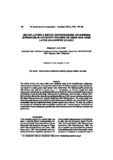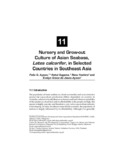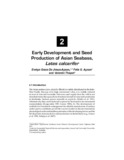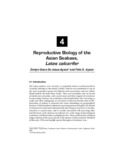Use of juvenile instar Diaphanosoma celebensis (Stingelin) in hatchery rearing of Asian sea bass Lates calcarifer (Bloch)
Share
Abstract
The effects of size, dry mass intake and nutritional value of the brackishwater cladoceran, Diaphanosoma celebensis, on the growth and survival of 15-30 day sea bass (Lates calcarifer) larvae reared in a static green water system were determined. The highest specific growth rate (29.4%/day) was attained in larvae fed a 1:1 combination of Artemia nauplii and adult Diaphanosoma but it was not significantly different (p>0.05) from fish fed only adult Diaphanosoma (28.8%/day) or only juvenile instar Diaphanosoma (28.6%/day). Survival rates of larvae (92.4-99.0%) fed the different live diets did not significantly differ (p>0.05). Larvae markedly prefered juvenile instar Diaphanosoma over Artemia nauplii and adult Diaphanosoma. The crude protein contents of juvenile Diaphanosoma (58.7%), adult Diaphanosoma (58.3%) and Artemia (56.7%) were substantially high and satisfied the dietary protein requirements of larvae. The fatty acid profile of the sea bass fry reflected the lipid composition of the live diet. Improved growth, survival and dry mass intake in larvae indicate the potential of juvenile Diaphanosoma in the hatchery rearing of sea bass larvae.
Suggested Citation
de la Peña, M. R. (2001). Use of juvenile instar Diaphanosoma celebensis (Stingelin) in hatchery rearing of Asian sea bass Lates calcarifer (Bloch). The Israeli Journal of Aquaculture-Bamidgeh , 53(3-4), 128-138. http://hdl.handle.net/10862/1895
Subject
Taxonomic term
Collections
- AQD Journal Articles [1240]
Related items
Showing items related by title, author, creator and subject.
-
Nursery and grow-out culture of Asian seabass, Lates calcarifer, in selected countries in Southeast Asia
Ayson, Felix G.; Sugama, Ketut; Yashiro, Renu; de Jesus-Ayson, Evelyn Grace (CRC Press, 2014)In this chapter, the practices of growing Asian seabass in nursery and grow-out culture systems in selected Southeast Asian countries like the Philippines, Thailand and Indonesia are described. -
Early development and seed production of Asian seabass, Lates calcarifer
de Jesus-Ayson, Evelyn Grace; Ayson, Felix G.; Thepot, Valentin (CRC Press, 2014)This Chapter outlines the characteristics of L. calcarifer eggs and larvae, the changes during embryonic and larval development, advances in seed production and at the same time highlights the relative ease in its mass production. -
Reproductive biology of the Asian seabass, Lates calcarifer
de Jesus-Ayson, Evelyn Grace; Ayson, Felix G. (CRC Press, 2014)






